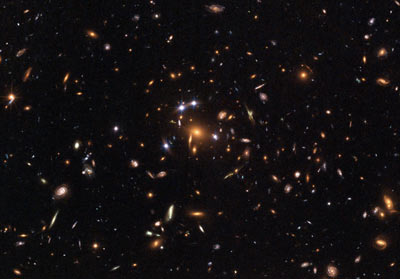Avi Blizovsky

The Hubble Space Telescope took the first image of a group of distant star-like objects - five different figures of one quasar.
The image doubling effect seen in the image taken by the Hubble was created by a process known as "gravitational lensing", whereby the gravitational fields of a heavy object - in this case a galaxy cluster - bends and amplifies light from an object - in this case a quasar - located far behind it.
Although many examples of gravitational lensing have already been observed, the pentagonal quasar is the only case so far in which a multiple multiplication of a quasar image is produced by an entire galaxy cluster acting as a gravitational lens.
The quasar in the background is a bright nucleus of a galaxy. It's powered by a black hole, gobbling up gas and dust and creating a sort of oil well of light in the process. When the light from the quasar passes through the gravitational field of a galaxy cluster, which lies between us and the quasar, the light is bent by the gravitational field causing space to curve in such a way that five separate images of the object are formed as they surround the center of the cluster. The fifth image of the quasar is integrated to the right of the nucleus of the central galaxy in the cluster. The cluster also creates a spider web of images of other galaxies that have been gravitationally compressed and turned into rainbows.
The galaxy cluster that formed the lens is called SDSS J1004+4112 and was first discovered by the Sloan Digital Sky Survey. It is one of the most distant clusters known (it is 7 billion light-years away from us), and is seen at an age when the universe was half its current age.
Pictures taken by the KC-1 telescope in Hawaii that were 10 meters in diameter showed that these were pictures of the same galaxy. The spectral results are consistent with those proposed by the lens model based on the position of the galaxies in the image and the measurement of the light emitted by the quasar. Although this cluster has been imaged several times in the past, so far only four of the quasar's five outflows have been seen. Hubble's sharp sight and the great magnification of gravitational lensing combined to place the fifth image far enough from the center of the galaxy to make this image visible as well.
The galaxy whose shell we see as a quasar is 10 billion light years away. It appears in the picture as a series of pale red arcs. It is the most magnified quasar host galaxy to date.
The Hubble image shows a large number of arcs originating from more distant galaxies behind the cluster, each divided into several images. The most distant galaxy detected has been confirmed to be 12 billion light-years away, meaning we see it today as it was 1.8 billion years after the Big Bang.
By comparing the images of the cluster with those taken by Hubble a year earlier, the researchers discovered a rare event - a supernova explosion in one of the cluster's galaxies. The supernova exploded as mentioned 7 billion years ago, and the data, together with other supernova observations, are used to try to reconstruct how the universe was enriched with heavy elements through these explosions.
